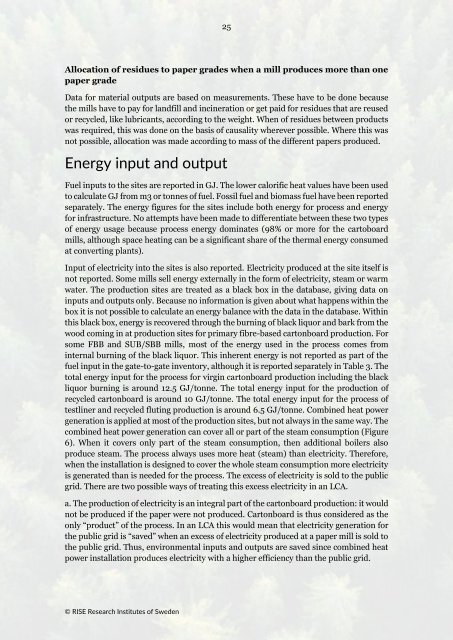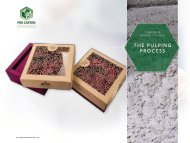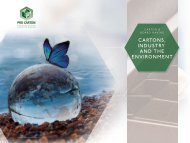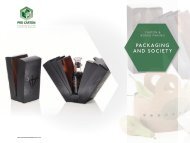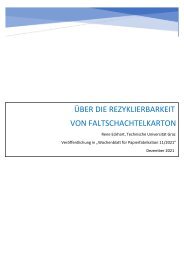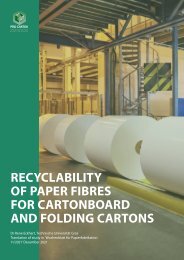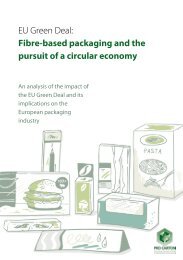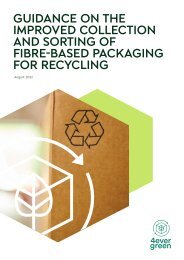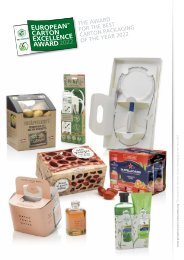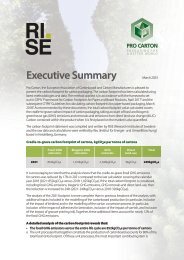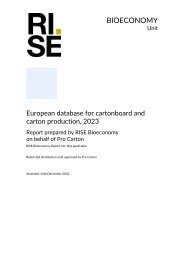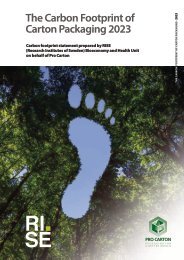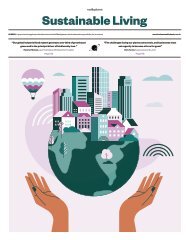European Database for Cartonboard and Carton Production 2023
Create successful ePaper yourself
Turn your PDF publications into a flip-book with our unique Google optimized e-Paper software.
22<br />
Some converting plants use gravure printing processes <strong>for</strong> high-volume cartons, but this<br />
is less common. Gravure printing is more energy intensive compared to other printing<br />
processes. There<strong>for</strong>e, weighted average datasets were prepared <strong>for</strong> plants with gravure<br />
printing processes on site <strong>and</strong> <strong>for</strong> plants without gravure printing onsite, <strong>and</strong> these were<br />
then combined to produce the overall weighted average <strong>for</strong> converting processes. In<br />
preparing this overall weighted average, the following shares were considered <strong>for</strong> gravure<br />
<strong>and</strong> non-gravure printing:<br />
• Share of sites with gravure printing – 11.1%<br />
• Share of sites without gravure printing – 88.9%<br />
In the aggregated dataset <strong>for</strong> carton production, the relative virgin <strong>and</strong> recycled<br />
cartonboard shares are used to calculate the inputs <strong>and</strong> outputs <strong>for</strong> the weighted average<br />
cartonboard. The paper production inputs <strong>and</strong> outputs are then multiplied with the<br />
average input of paper (1.1689 tonnes of cartonboard per tonne of cartons) <strong>and</strong> added up<br />
to the inputs <strong>and</strong> outputs per tonne of carton converting as reported in the Annex. This<br />
total includes the production of the cartonboard that is used to produce the cartons,<br />
including the 14.5% losses that are reported as “paper <strong>for</strong> recycling”. It has to be kept in<br />
mind that the industry averages <strong>for</strong> inputs of cartonboard, glue, inks, etc are used.<br />
<strong>Carton</strong>s are far from st<strong>and</strong>ardised <strong>and</strong> inputs of depend on the specific box design.<br />
Material inputs<br />
Raw materials - fibre<br />
The wood input has been reported as bone dry solid wood under bark. The species are<br />
specified, although in the datasets they are reported only as softwood or hardwood.<br />
>80% of the pulp wood used <strong>for</strong> the production of cartonboard by the companies<br />
returning the survey was certified <strong>and</strong> third party verified as being sourced from<br />
sustainable managed <strong>for</strong>ests <strong>and</strong> delivered through a certified chain-of-custody system<br />
(PEFC or similar). A similar proportion of the purchased pulp is also certified <strong>and</strong> third<br />
party verified as being sourced from sustainable managed <strong>for</strong>ests. The input of recovered<br />
paper has been reported as total weight including moisture <strong>and</strong> other materials (s<strong>and</strong>,<br />
metal objects, plastics, wood etc.). In <strong>European</strong> countries the water content of recovered<br />
paper is generally assumed to be about 10%. The total input of recovered paper is given.<br />
The content of other materials in the recovered paper is about 8%. These materials are<br />
eliminated from the pulp as rejects during the pulping. It is estimated that about a third<br />
of these rejects are materials that were associated with the previous use of the paper (<strong>for</strong><br />
example, staples, paper clips, tags, adhesive labels, unrecovered fibres, etc). The<br />
remaining two thirds is material that is not in any way associated with the previous use<br />
of the paper (<strong>for</strong> example, <strong>for</strong>eign items such as textiles, plastic packaging, glass, s<strong>and</strong><br />
<strong>and</strong> grit, etc).<br />
Non-integrated <strong>and</strong> semi-integrated mills buy mechanical <strong>and</strong> chemical pulp. The pulp<br />
data are reported in bone dry 4 weight, which is normally 90% of the wet (air dry) weight.<br />
4 Bone dry weight: weight without any water<br />
© RISE Research Institutes of Sweden


